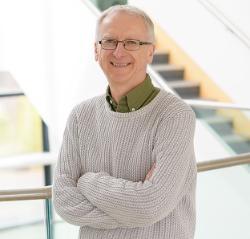cSTAR – Finding the influencers to turn off cancer in cells
How does a cell become a cancer cell? What factors influence it on that journey? And can we convince a cancer cell to return to being a non-cancer cell?
Those are the questions at the heart of cSTAR, a project that combines computational modelling and biology to seek ways to ‘rehabilitate’ cancer cells and turn them into normal cells.
 It sounds like alchemy, but cSTAR is pointing the way to making it real, according to Precision Oncology Ireland director Professor Walter Kolch, who co-leads the cSTAR project with fellow UCD researchers Professor Boris Kholodenko and Dr Oleksii Rukhlenko. “Turning cancerous cells in a patient back to normal cells would change the landscape of cancer treatment,” says Professor Kolch. “And yes, it does sound like science fiction, but computational models are allowing us to work out what happens inside a cancer cell.”
It sounds like alchemy, but cSTAR is pointing the way to making it real, according to Precision Oncology Ireland director Professor Walter Kolch, who co-leads the cSTAR project with fellow UCD researchers Professor Boris Kholodenko and Dr Oleksii Rukhlenko. “Turning cancerous cells in a patient back to normal cells would change the landscape of cancer treatment,” says Professor Kolch. “And yes, it does sound like science fiction, but computational models are allowing us to work out what happens inside a cancer cell.”
The team at Systems Biology Ireland in UCD has, for many years, built up expertise on cell states and fates and how to control them. And through the Precision Oncology Ireland strategic partnership programme, the researchers have been able to link in with clinicians, patient samples and a wide network of essential expertise. The result is that cSTAR is now a powerful approach to tackling major challenges in human cancers.
At its heart, the cSTAR project builds ‘digital twins’ or computer models of individual cells, drawing on many strands of information, including genetics and networks of other molecular components and interactions.
“We use machine learning in these computer models to classify the state of each cell,” explains Professor Kolch. “This allows us to compare cells that are cancerous and cells that are not cancerous. But, better than this, cSTAR can find the influencers that keep cells in the cancerous or non-cancerous state.”
This is one of the big cSTAR innovations - it provides a list of key molecules in cells that determine and maintain one state or another, cancerous or normal, he says.
“This is a huge innovation, because it means we can identify the big influencers, the molecules and pathways that make a big difference to the state of the cell.”
And when you know who the influencers are, you can give them a nudge, notes Professor Kolch.
“The computational models help us to identify which molecules need to be targeted in cancer cells to set the cells back on the path away from being cancerous,” he explains.
“We can simulate in the computational models what will happen to the cell, then we test it out on cells in the lab, to see if it happens in real life too.”
And what have they found?
“The approach has been working phenomenally in the lab,” says Professor Kolch, who adds that the potential for finding such restorative treatments is not limited to cancer either.
“We have not yet found an instance where this approach has not worked in the lab, and that includes the kinds of changes seen in infectious diseases such as tuberculosis and chronic conditions such as cardiovascular disease,” he says.
Being able to identify and control the influencers and thereby change the entire cell’s behaviour is the key, he explains, and this could change the paradigm of how we approach cancer treatment in the future.
“At the moment, cancer treatments are about killing the cancer cells, which works in many cases, but it can also create environments where cancer cells find ways around the treatments,” he says.
”cSTAR is about developing a softer approach where we encourage the cells to lose their cancer properties, and this could mean much gentler treatments for the patient. Effectively, cancer would become a more manageable disease.”